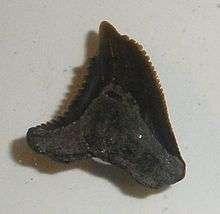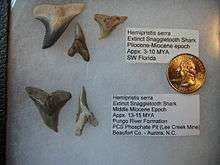Hemipristis serra
Hemipristis serra is an extinct species of weasel shark which existed during the Miocene epoch. It was described by Louis Agassiz in 1843.[1] While today's snaggletooth shark is not very large or dangerous, Hemipristis serra, which lived in the Atlantic Ocean during the Oligocene and Miocene, was considerably larger than its modern-day relative and had much larger teeth. Marks made by the teeth of H. serra are often found on the bones of the manatee Metaxytherium leading some scientists to hypothesize that H. serra specialized in preying on these sirenians.
| Hemipristis serra | |
|---|---|
 | |
| Tooth series of Hemipristis serra | |
| Scientific classification | |
| Kingdom: | Animalia |
| Phylum: | Chordata |
| Class: | Chondrichthyes |
| Order: | Carcharhiniformes |
| Family: | Hemigaleidae |
| Genus: | Hemipristis |
| Species: | H. serra |
| Binomial name | |
| Hemipristis serra (Agassiz, 1843) | |


The unusual teeth of Hemipristis serra are highly prized by collectors because they are often found in sediments in Southern Florida that yield extremely colorful fossil shark teeth. Their outstandingly large serrations make it a favorite and unique collectible fossil.
References
- Miocene, Volume 2, Part 1 Miocene, Maryland Geological Survey. Johns Hopkins Press, 1904.